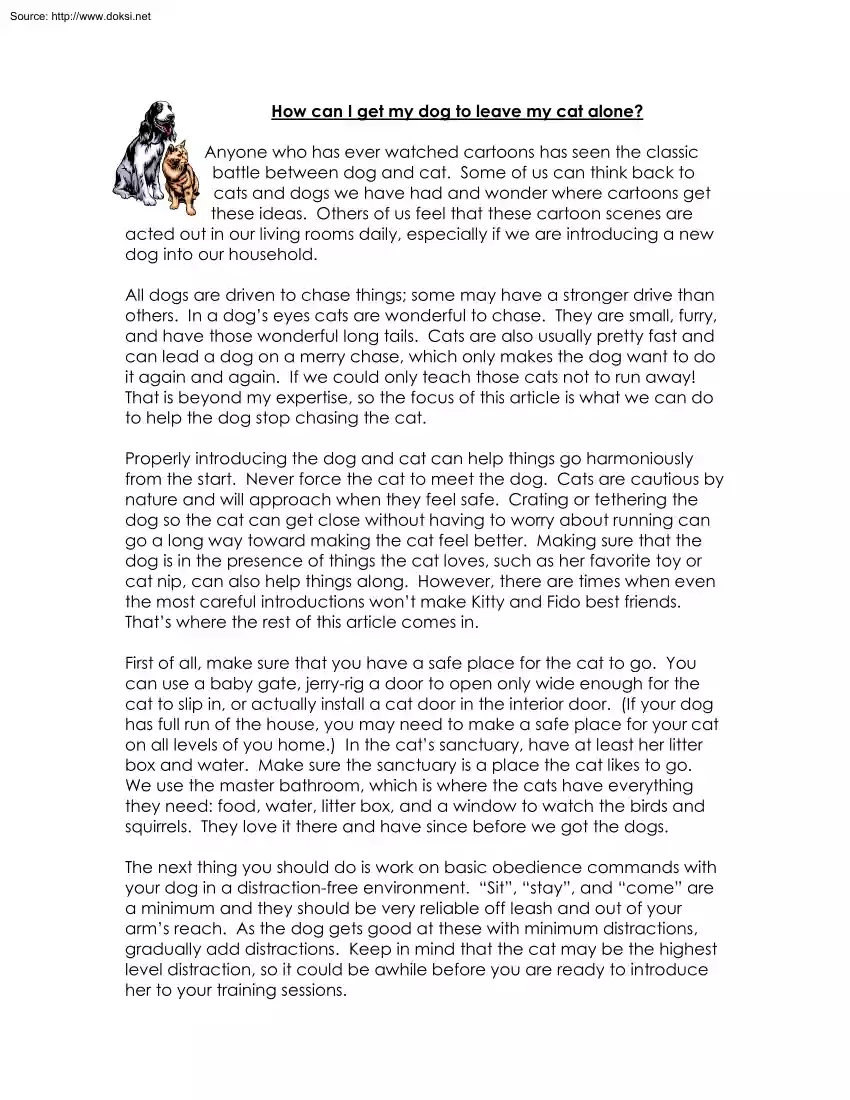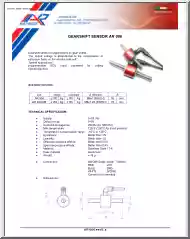Please log in to read this in our online viewer!

Please log in to read this in our online viewer!
No comments yet. You can be the first!
What did others read after this?
Content extract
Source: http://www.doksinet How can I get my dog to leave my cat alone? Anyone who has ever watched cartoons has seen the classic battle between dog and cat. Some of us can think back to cats and dogs we have had and wonder where cartoons get these ideas. Others of us feel that these cartoon scenes are acted out in our living rooms daily, especially if we are introducing a new dog into our household. All dogs are driven to chase things; some may have a stronger drive than others. In a dog’s eyes cats are wonderful to chase They are small, furry, and have those wonderful long tails. Cats are also usually pretty fast and can lead a dog on a merry chase, which only makes the dog want to do it again and again. If we could only teach those cats not to run away! That is beyond my expertise, so the focus of this article is what we can do to help the dog stop chasing the cat. Properly introducing the dog and cat can help things go harmoniously from the start. Never force the cat to meet the
dog Cats are cautious by nature and will approach when they feel safe. Crating or tethering the dog so the cat can get close without having to worry about running can go a long way toward making the cat feel better. Making sure that the dog is in the presence of things the cat loves, such as her favorite toy or cat nip, can also help things along. However, there are times when even the most careful introductions won’t make Kitty and Fido best friends. That’s where the rest of this article comes in. First of all, make sure that you have a safe place for the cat to go. You can use a baby gate, jerry-rig a door to open only wide enough for the cat to slip in, or actually install a cat door in the interior door. (If your dog has full run of the house, you may need to make a safe place for your cat on all levels of you home.) In the cat’s sanctuary, have at least her litter box and water. Make sure the sanctuary is a place the cat likes to go We use the master bathroom, which is where
the cats have everything they need: food, water, litter box, and a window to watch the birds and squirrels. They love it there and have since before we got the dogs The next thing you should do is work on basic obedience commands with your dog in a distraction-free environment. “ Sit” , “ stay” , and “ come” are a minimum and they should be very reliable off leash and out of your arm’s reach. As the dog gets good at these with minimum distractions, gradually add distractions. Keep in mind that the cat may be the highest level distraction, so it could be awhile before you are ready to introduce her to your training sessions. Source: http://www.doksinet While you are working on reliable obedience, either separate the dog and cat or tether the dog to you when he is in a place where he might encounter the cat. I use a simple leash tied to my belt loop. (Take caution in doing this – if your dog can pull you off your feet, don’t risk getting hurt! Work more on separating
the dog and cat until you feel more comfortable with their interaction.) When the dog sees the cat and tries to get her, I stop dead and wait. Saying things to the dog at this point, especially rapidly repeated things (i.e “ no no no no!” ) will just get him more excited, so I wait silently. As soon as the dog puts any slack in the leash at all (and this could take several minutes), praise the dog wildly with treats, a game, and/or petting and scratching his favorite spot. Once the dog starts to get the idea that you like it when he’s not so intent on the cat, you can start finding things that he may be willing to like more than the cat. Since most dogs are attracted to the cat because of the chase, offer a much more fun chase game in the opposite direction. Call the dog’s name in a happy voice and when he looks your way, be bouncy and exciting and head away from the cat. When the dog starts moving toward you start to praise him and find a toy for him to play with. Even if the
dog quickly looses interest in you and wants to head toward the cat again, you’ve given the cat enough time to get away and you have reinforced the dog for leaving the cat alone. All the dog wants is some fun. If you provide that fun instead of scolding the dog for going after the cat, he is more likely to choose you over the cat the next time you call him. What I’ve described above is my preferred method for getting a dog to leave the cat alone. However, I recognize that while most dogs will respond to this, they won’t necessarily all do it. If this is the case, or you need something to use for a quick fix as you work on the above exercise, there are some things that you can try. One of the simplest things to do is just to scold the dog as he goes after the cat. If your dog is very sensitive, a firm “ Fido, NO! Come” may be enough to make your dog leave the cat alone. Most labs aren’t very sensitive, though. In these cases you’ll need to set up some props Try to
determine where you dog and cat interact the most. Place a squirt bottle or good squirt gun filled with water and a little Listerine or vinegar near the places where you dog meets the cat. If the dog ignores you, spray him with the water solution. (For Labs I recommend adding a little something to the water because most of them aren’t phased by plain Source: http://www.doksinet water. The smell of mouthwash or vinegar is unpleasant enough to act as a mild punishment.) If your dog is not terrified of sudden noises, you can also try a penny can. Take an empty soda can and put about 10 pennies in it. Duct tape the top of the can closed. If you try to call the dog off the cat and he doesn’t respond to you, throw the can NEAR but not AT the dog. You don’t want to hit him! And please, please don’t do this if it will terrify your noisesensitive dog. We are not looking to traumatize the dog, just teach him that it isn’t worth it to go after the cat. Another way to use the penny
can is to set the dog up. Have someone hide with the can and let the dog and cat interact. If the dog goes after the cat, let the can “ appear from nowhere” . You don’t want the dog to see where the can comes from, so he learns that it isn’t ok to bother the cat whether he’s alone or with humans. Remember, the goal is NOT to hit the dog with the can; the goal is to startle him. Regardless of what method you end up using, it will take some time. Keep in mind that the dog is not only getting used to the idea of a cat in his house, but also his new people, routine, and what these people expect of him. It may take a month or more for things to settle into a somewhat normal existence. Also remember not to tempt fate by allowing the cat and dog to be together if you are not around to supervise. Sometimes the best-behaved dogs can get too rough in play, which can result in injury or worse. Crating the dog, or closing him in one area while the cat is in another area is a wise safety
precaution, even if you don’t feel it is necessary. Machi the cat and Cousteau the dog don’t love each other, but they do co-exist fairly peacefully in the author’s home
dog Cats are cautious by nature and will approach when they feel safe. Crating or tethering the dog so the cat can get close without having to worry about running can go a long way toward making the cat feel better. Making sure that the dog is in the presence of things the cat loves, such as her favorite toy or cat nip, can also help things along. However, there are times when even the most careful introductions won’t make Kitty and Fido best friends. That’s where the rest of this article comes in. First of all, make sure that you have a safe place for the cat to go. You can use a baby gate, jerry-rig a door to open only wide enough for the cat to slip in, or actually install a cat door in the interior door. (If your dog has full run of the house, you may need to make a safe place for your cat on all levels of you home.) In the cat’s sanctuary, have at least her litter box and water. Make sure the sanctuary is a place the cat likes to go We use the master bathroom, which is where
the cats have everything they need: food, water, litter box, and a window to watch the birds and squirrels. They love it there and have since before we got the dogs The next thing you should do is work on basic obedience commands with your dog in a distraction-free environment. “ Sit” , “ stay” , and “ come” are a minimum and they should be very reliable off leash and out of your arm’s reach. As the dog gets good at these with minimum distractions, gradually add distractions. Keep in mind that the cat may be the highest level distraction, so it could be awhile before you are ready to introduce her to your training sessions. Source: http://www.doksinet While you are working on reliable obedience, either separate the dog and cat or tether the dog to you when he is in a place where he might encounter the cat. I use a simple leash tied to my belt loop. (Take caution in doing this – if your dog can pull you off your feet, don’t risk getting hurt! Work more on separating
the dog and cat until you feel more comfortable with their interaction.) When the dog sees the cat and tries to get her, I stop dead and wait. Saying things to the dog at this point, especially rapidly repeated things (i.e “ no no no no!” ) will just get him more excited, so I wait silently. As soon as the dog puts any slack in the leash at all (and this could take several minutes), praise the dog wildly with treats, a game, and/or petting and scratching his favorite spot. Once the dog starts to get the idea that you like it when he’s not so intent on the cat, you can start finding things that he may be willing to like more than the cat. Since most dogs are attracted to the cat because of the chase, offer a much more fun chase game in the opposite direction. Call the dog’s name in a happy voice and when he looks your way, be bouncy and exciting and head away from the cat. When the dog starts moving toward you start to praise him and find a toy for him to play with. Even if the
dog quickly looses interest in you and wants to head toward the cat again, you’ve given the cat enough time to get away and you have reinforced the dog for leaving the cat alone. All the dog wants is some fun. If you provide that fun instead of scolding the dog for going after the cat, he is more likely to choose you over the cat the next time you call him. What I’ve described above is my preferred method for getting a dog to leave the cat alone. However, I recognize that while most dogs will respond to this, they won’t necessarily all do it. If this is the case, or you need something to use for a quick fix as you work on the above exercise, there are some things that you can try. One of the simplest things to do is just to scold the dog as he goes after the cat. If your dog is very sensitive, a firm “ Fido, NO! Come” may be enough to make your dog leave the cat alone. Most labs aren’t very sensitive, though. In these cases you’ll need to set up some props Try to
determine where you dog and cat interact the most. Place a squirt bottle or good squirt gun filled with water and a little Listerine or vinegar near the places where you dog meets the cat. If the dog ignores you, spray him with the water solution. (For Labs I recommend adding a little something to the water because most of them aren’t phased by plain Source: http://www.doksinet water. The smell of mouthwash or vinegar is unpleasant enough to act as a mild punishment.) If your dog is not terrified of sudden noises, you can also try a penny can. Take an empty soda can and put about 10 pennies in it. Duct tape the top of the can closed. If you try to call the dog off the cat and he doesn’t respond to you, throw the can NEAR but not AT the dog. You don’t want to hit him! And please, please don’t do this if it will terrify your noisesensitive dog. We are not looking to traumatize the dog, just teach him that it isn’t worth it to go after the cat. Another way to use the penny
can is to set the dog up. Have someone hide with the can and let the dog and cat interact. If the dog goes after the cat, let the can “ appear from nowhere” . You don’t want the dog to see where the can comes from, so he learns that it isn’t ok to bother the cat whether he’s alone or with humans. Remember, the goal is NOT to hit the dog with the can; the goal is to startle him. Regardless of what method you end up using, it will take some time. Keep in mind that the dog is not only getting used to the idea of a cat in his house, but also his new people, routine, and what these people expect of him. It may take a month or more for things to settle into a somewhat normal existence. Also remember not to tempt fate by allowing the cat and dog to be together if you are not around to supervise. Sometimes the best-behaved dogs can get too rough in play, which can result in injury or worse. Crating the dog, or closing him in one area while the cat is in another area is a wise safety
precaution, even if you don’t feel it is necessary. Machi the cat and Cousteau the dog don’t love each other, but they do co-exist fairly peacefully in the author’s home




